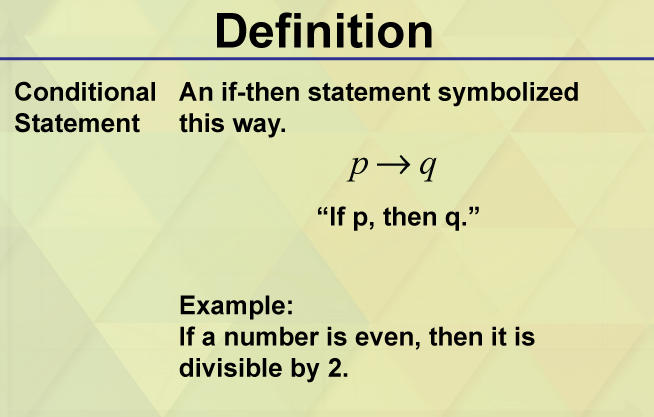Unit 2 Lesson 2 Conditional Statements
Unit 2 Lesson 2: Conditional Statements
Lesson Overview
What is an If-Then Statement?
What You Will Learn
- Using if-then statements to find the truth value of an argument.
- Evaluate arguments that use conditional statements.
Overview
 In this lesson, you will learn how to use if-then statements to find the truth value of arguments. You will show your understanding by evaluating arguments that use conditional statements.
In this lesson, you will learn how to use if-then statements to find the truth value of arguments. You will show your understanding by evaluating arguments that use conditional statements.
Essential Understanding
You can describe some mathematical relationships using a variety of if-then statements.
- Read pages 11-17 in your course textbook.
This course is based on a textbook that is viewable by clicking on the textbook icon. Keep the textbook open while you go through the lesson so that you may refer to it throughout the lesson.
Additional Resources
Lesson 2: Conditional Statements
Proceed to Next Page
Prepare for Application
Instructions
You have now studied Conditional Statements. It is now time to demonstrate your learning.
Try the activities below on your own. You should be able to answer these before beginning the practice.
Do these activities in your journal.
Activity 1
What are the hypothesis and the conclusion of the conditional statement below?
If an angle measures 130, then the angle is obtuse.
Activity 2
How can you write 'Dolphins are mammals' as a conditional statement?
Activity 3
Find the truth value of the conditional statements. If it is false, find a counterexample.
- If a month has 28 days, then it is February.
- If two angles form a linear pair, then they are supplementary.
Activity 4
What are the converse, inverse, and contrapositive of the conditional statement below? What are the truth values of each? If a statement is false, give a counterexample.
If a vegetable is a carrot, then it is orange.




